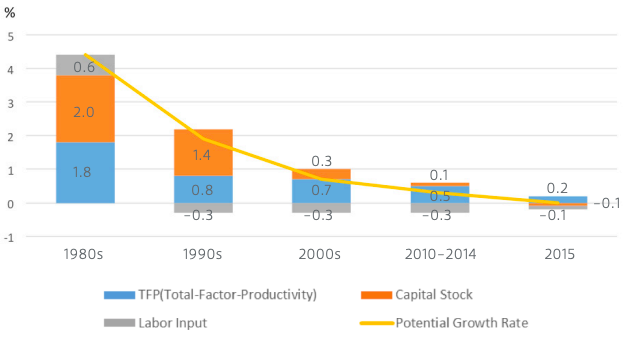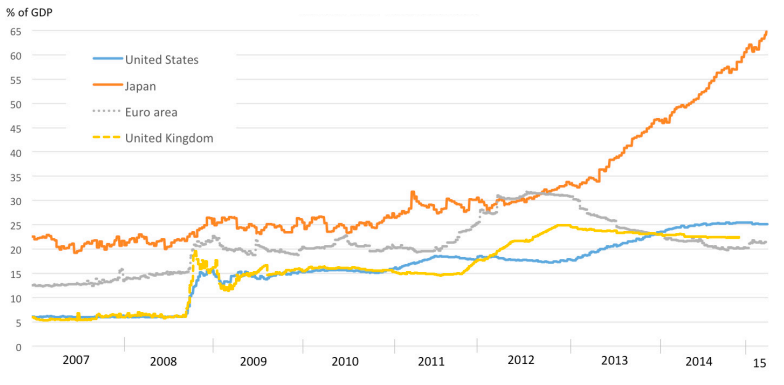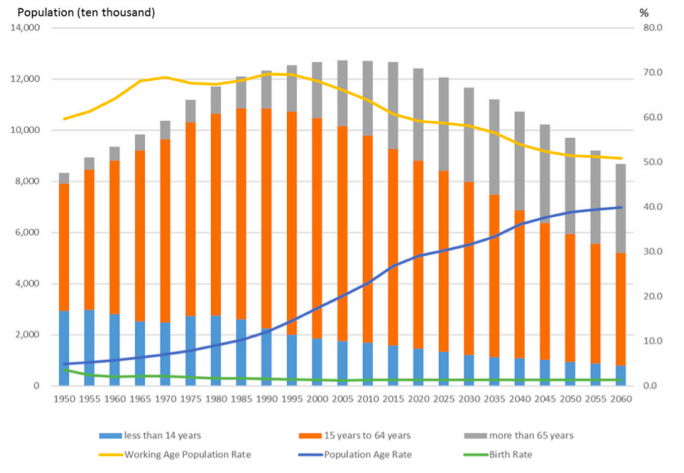What Happened to “Japan as Number One”?

Table of Contents
Author(s)
Masaaki Yoshimori
Contributing Expert, International Economics ProgramRussell Green
Former FellowShare this Publication
- Download PDF
- Print This Publication
- Cite This Publication Copy Citation
Yoshimori, Masaaki and Russell A. Green. 2016. What Happened to “Japan as Number One”? Issue Brief no. 08.26.16. Rice University’s Baker Institute for Public Policy, Houston, Texas.
Ezra Vogel, professor emeritus of social science at Harvard University, published the book Japan as Number One in 1979, and it shocked Americans confident in their country’s dominance of the world economy.1 In the 1980s, the robust Japanese economy confirmed Vogel’s thesis, and experts around the world predicted continued success. However, after the collapse of the asset price bubble in the 1990s, Japan experienced two “lost” decades of nearly zero growth. The Japanese economy has been somnolent, mainly as a result of deflation and decreased productivity.
To exit these economic conditions, Japan launched a three-pillar approach known as “Abenomics”2 in 2013. Abenomics comprises a bold monetary policy developed by the Bank of Japan (BoJ), fiscal stimulus launched by the Ministry of Finance (MOF), and growth-focused structural reforms implemented by the Ministry of Economy, Trade and Industry (METI). How has Japan’s reform agenda progressed, and what are the prospects for returning to a healthy economy? This paper discusses Abenomics’ three pillars and the headwinds created by the demographic forces of aging.
Why Has the Japanese Economy Experienced Sluggishness for Almost 25 Years?
The Japanese economy has experienced low or negative inflation since 1998. One reason is weak demand, as evidenced by Japan’s Philips curve. A Phillips curve is the tradeoff between inflation and unemployment; if jobs translate into demand, inflation will rise. The Japanese Phillips curve in the 1990s was gently sloped, an indicator of weak demand. From 2000 to 2014 it became almost flat, indicating an unwillingness of individuals to spend. Because of weak demand, companies were unable to raise prices. In fact, they were likely to lower their selling price to match emerging low-price competitors. Japanese consumers began to believe that prices would keep going down, which further depressed demand.
Supply-side factors such as falling productivity have mattered, too. The total output of the Japanese economy during the 1980s, growing at an average of 4.4 percent a year, outstripped that of other advanced economies, while output after 1990 has been declining. Figure 1 shows anemic total factor productivity (TFP) growth is a predominant cause of the decreased output.
Figure 1 — Factors Contributing to Growth Rate

Why has TFP been dropping? Two factors are at play: zombie companies and diminished competitive power. First, through “evergreen” loans—or new loans that repay old, bad debt—and discounted lending rates by private banks, low-productivity companies called “zombie companies” stayed alive during the 1990s and 2000s. Accordingly, it was difficult for new, profitable firms to enter the market and replace old, inefficient firms.
Second, Japanese companies lost competitive power in the world market. In fact, Japan’s share of world exports plummeted to 3.6 percent in 2014 from 6.6 percent in 2000. This was the result of the rapid growth of China and other emerging economies beginning in 2000, but it was also due to unsuccessful product development strategies in corporate Japan. Companies paid insufficient attention to consumer needs in broad markets and instead pursued expensive, top-of-the-line products that proved to have only niche markets. Japanese mobile phones are a good example of what has sometimes been called the “Galapagos Syndrome.”3 For years Japan produced the most cutting-edge cell phones, but their features became too focused on Japanese consumers and proprietary standards. Without global compatibility, Japan’s status as one of the world’s leading cell phone producers was eventually wiped out by smartphone producers in other countries.
Monetary Policy Is Challenging Deflation
Through the introduction of “inflation targeting” in 2013, the BoJ hoped to raise the public’s expectations of future inflation. The key target of monetary policy is the real interest rate—the nominal rate minus expected future inflation. So raising inflation expectations can lower the real interest rate even when nominal rates do not change. Besides encouraging borrowing through lower real rates, higher inflation expectations encourage consumption demand. When inflation expectations rise, the yen is expected to be less valuable in the future for buying domestic or foreign goods and services.
In order fully to overcome deflation, the BoJ embarked on an unprecedented asset purchase program called quantitative easing (QE) and set a “price stability target of 2 percent.”4 This was followed at the beginning of 2016 by a modest new negative interest rate policy.
The inflation goal still has not been met, however. The BoJ never managed to raise public inflation expectations. Plus, China’s economic slowdown and falling oil prices have pushed prices lower globally. Many economists criticized Japan’s 2015 goal because it was a very high hurdle for a tight time-frame of only two years. There is now the additional risk of the market disbelieving the next goal.
The main innovation in monetary policy designed to impact inflation expectations was QE. The BoJ’s balance sheet grew enormously, even when compared to other countries’ QE efforts: it has grown from 25 percent of GDP to 75 percent of GDP, compared with 25 percent of GDP for the Federal Reserve Bank (Fig. 2).
Figure 2 — Central Bank Balance Sheets

In 2015, the BoJ did not enact what is called QE3, despite the predictions of many market analysts. Instead, in January 2016, the bank announced it had set the benchmark interest rate to minus 0.1 percent. This was a modest step, representing less than a quarter-point move, and it applies to only a small fraction of accounts. Perhaps because of the small scale of the move, it has not appeared to have much impact.
Until February 2016, loose monetary policy also caused the yen to fall, boosting inflation through import prices and helping exporters compete. Export volumes did not respond, but the profits from exports became more valuable in yen terms. The stock market rose on the back of these rising profits. In theory, this could also spur consumption through wealth effects and investment, but there is little evidence of this. At best, the enyasu, the Japanese term for the weak yen, helped counter a long-run trend to offshoring that otherwise would have caused investment to fall.
Since February 2016, the yen has strengthened (endaka), causing consternation among economic policymakers. In addition, inflation and inflation expectations have declined in recent months. Overall, it appears the monetary side of Abenomics may have lost momentum.
Fiscal Stimulus
To make economic growth a priority, Abenomics includes further fiscal stimulus. In theory, the resulting economic growth will generate government revenue sufficient to offset the borrowing needed to fund it.
The first fiscal stimulus package was 10.2 trillion yen (2.1 percent to GDP) in February 2013, and the second was 5.5 trillion yen (1.1 percent to GDP) in February 2014. In addition, the government of Prime Minister Shinzō Abe has postponed a 2 percentage point increase in the consumption tax between October 2015 and April 2017, citing sluggish economic conditions after the tax rose to 8 percent in 2014. (A similar tax increase infamously killed off another nascent recovery in 1997.)
Concerns about fiscal sustainability are constraining the Abenomics fiscal stimulus program. Japan’s gross debt-to-GDP ratio reached 245 percent in 2014, which is higher than that of Greece. Looming alongside the debt-to-GDP ratio are the government’s future obligations for social spending, estimated to add another 25 percent of GDP to the total liabilities the government faces. To make the nation’s finances sustainable, on the other hand, the government must control public social spending, including health care and pensions.
Given concerns about fiscal sustainability, how have Japanese government bond (JGB) yields remained low and stable? Seven reasons explain the low level. 1) More than 90 percent of JGBs are held by Japanese residents. Foreign bond holders tend to demand higher yields and are therefore less reliable lenders. 2) The MoF has put pressure on the three mega banks, MUFG, Mizuho and SMBC, to buy large quantities of JGBs. 3) Japanese private banks are more likely to purchase JGBs than foreign bonds because JGBs have no currency risk and carry a zero risk weight for bank capital requirements. 4) Due to the stagnation of Japan’s economy, corporate loans have been low performing, so banks have preferred buying JGBs over lending money. 5) Private savings and the high internal reserves kept by Japanese companies are deposited in banks. 6) Savings accounts have maintained near-zero interest rates, so households see even the low JGB yield as a fairly attractive investment. 7) The low interest rate policy through BoJ’s forward guidance and asset purchases has influenced JGB yields.
Could JGB yields abruptly rise? Hoshi and Ito (2014) conclude the yield will rise when government debt exceeds private sector demand for government debt, which could happen in the next 10 years.5 Their main concern is that neither corporate nor household savings can be maintained at current levels. First, if investment picks up as hoped, corporate savings will decrease. Second, the aging population will cause household savings to drop because retired individuals cannot support themselves on their pensions only. The average maturity of Japanese government debt is eight years, so higher yields would feed through to raise fiscal cost of debt service fairly quickly. This is a risk that Japanese officials will need to monitor closely as fiscal stimulus continues
Structural Reform
Economists have long advocated deep structural reforms—supply-side policy changes that facilitate business—as a key step to improving Japanese productivity and growth. In June 2014, Abe announced a reform package that focuses on agriculture liberalization, corporate tax cuts, and an overhaul of regulation of the energy and health care sectors. Other parts of the structural reform agenda announced in September 2015 include the promotion of strategic industries like big data, artificial intelligence (AI), and other high-tech fields; programs to boost birth rates; and lowering social security retirement payments to reduce the burden on those in the workforce. Some have referred to these newer proposals as a “second Abenomics.”
If implemented, the Trans-Pacific Partnership (TPP) trade agreement promoted by the Abe government would be the most significant pillar of structural reform. The TPP benefits the Japanese economy in three ways: 1) It will make it easier for Japanese companies to expand overseas. This could improve productivity growth through greater supply chain development. 2) It will benefit the auto industry by reducing tariffs on its exports. 3) It will improve competition and raise productivity in domestic sectors by removing restrictions on inward foreign direct investment (FDI) and other forms of investment, as well as by removing service sector protections.
How much could the TPP affect the Japanese economy? Petri and Plummer (2016) calculate that Japan's economy would grow about 0.2 percent faster over the next 15 years, meaning GDP in 2030 will be 2.5 percent larger than it would be without the TPP.6
While many proposals have been made, so far only small steps have been taken on the structural reform agenda. The corporate tax was cut to 32 percent from 37 percent in 2015, and the same year the Abe Cabinet announced future cuts in the corporate tax rate to below 30 percent. Cutting the social security budget is still politically unviable.
A Shrinking and Aging Population
Beyond Abenomics, demographic change is the most important factor impacting the Japanese economy. According to a National Institute of Population and Social Security Research estimate, Japan’s rapidly aging population is projected to fall to 90 million people in 2055, about a 28 percent decrease. The labor force is shrinking by more than one million workers per year, and is forecast to fall 17 percent by 2030 and nearly 40 percent by 2050 (Fig. 3).
Figure 3 — Future Population of Japan

How will the demographic changes affect the Japanese economy? There will be two serious issues in particular: a lack of labor power and public social spending. Social spending was covered above, so here we focus on the diminished labor force.
Three strategies may offset the lack of labor in the short- and mid-term: increasing the participation of women in the workforce, allowing more foreign workers in the country, and encouraging workers to delay retirement. In 2014, the female participation rate in Japan’s labor force was 66 percent—an improvement of 3 percent over the rate observed in 2011—compared to the male participation rate of 85 percent. However, even if female labor force participation equals that of men—something not observed anywhere in the world—the overall labor force will still decline by 5 percent by 2030, according to the OECD.7 This is not a complete solution.
Foreign workers also could offset the labor shortage in Japan. Currently, foreign workers in Japan comprise only 2 percent of the workforce, a rate lower than in other OECD countries. Foreign laborers make up about 10 percent of the workforce in Europe and 16 percent in the U.S. To make the best use of foreign laborers, however, immigration regulations must be reformed immediately.
Social security reforms, such as reducing payments, may be intended to reduce the burden on working taxpayers, but they may also have the effect of encouraging workers to delay retirement. Such reforms are not popular in any country, and Japan is no exception. To the extent the Japanese government can specifically design benefit cuts to encourage later retirement, the cuts will have a larger impact on the overall problem.
In the long-term, the third strategy is to encourage a higher birth rate. Boosting fertility is essential to long-run growth; in 2015, the government set a goal to raise the fertility rate from 1.1 children per woman to 1.8. The goal is based on plans to improve the child-rearing environment in Japan. Abe has proposed programs that support having more children, such as expanding free preschool education, eliminating nursery school waiting lists, and income support for households with more than two children. By making childcare more readily available, such programs also promote female workforce participation.
Conclusion
The Abenomics strategy for overcoming deflation and achieving economic growth is based upon three pillars: easy monetary policy, fiscal stimulus, and structural reforms. It is premature to evaluate Abenomics because the strategy is still progressing. However, Koichi Hamada, special economic advisor to Abe and professor emeritus of economics at Yale University and the University of Tokyo, gave an accurate mid-course assessment of the plan.8 His grade for Abenomics is “ABE”: An “A” for monetary policy, “B” for fiscal policy and “E” (i.e., almost failing) for structural reform. Fading inflation expectations suggest monetary policy has run its course and cannot stimulate the economy further. Fiscal policy may have some room to maneuver, but is severely constrained by sustainability concerns. The only arrow in Abenomics that can travel further is structural reform. Without pushing deregulation, the Japanese economy cannot grow.
Endnotes
1. Ezra F. Vogel, Japan As Number One: Lessons for America (Harvard University Press, 1979).
2. “Abenomics” refers to the economic policies introduced by Japanese prime minister Shinzo Abe after his December 2012 re-election.
3. The term is a nod to the super-evolved species Darwin found on the Galapagos Islands that were very unlike those found elsewhere in the world. In a similar vein, Japanese cell phones became so specialized they were largely incompatible with technology in other parts of the world.
4. “We should do whatever is necessary to overcome deflation,” Kuroda said.
5. Takeo Hoshi and Takatoshi Ito, “Japanese Debt,” Economic Policy, January 2014, 5-44.
6. Peter Petri and Michael G. Plummer, “The Trans-Pacific Partnership and Asia-Pacific Integration: New Estimates,” Peterson Institute for International Economics Policy, Working Paper Series WP 16-2, 2016, https://piie.com/publications/wp/wp16-2.pdf.
7. Organisation for Economic Cooperation and Development, OECD Economic Survey of Japan, April 2015, http://www.oecd.org/eco/surveys/economic-survey-japan.htm.
8. Hamada Koichi, “Grading Abenomics,” Project Syndicate, 2013, https://www.project-syndicate.org/commentary/koichi-hamada-assesses-the-progress-that-japanese-prime-minister-shinzo-abe-s-three-arrows--strategy-for-economic-revitalization-has-made-so-far.
This material may be quoted or reproduced without prior permission, provided appropriate credit is given to the author and Rice University’s Baker Institute for Public Policy. The views expressed herein are those of the individual author(s), and do not necessarily represent the views of Rice University’s Baker Institute for Public Policy.


